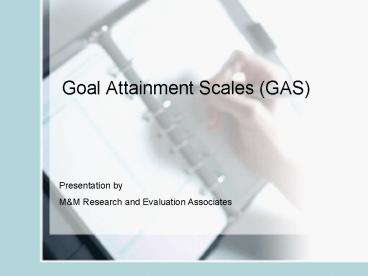Goal Attainment Scales GAS - PowerPoint PPT Presentation
1 / 17
Title:
Goal Attainment Scales GAS
Description:
Refer to the GAS conversion table on the following . ... Goal Attainment Score Conversion Table. Example 1. Example 2. Example 3 ... – PowerPoint PPT presentation
Number of Views:540
Avg rating:3.0/5.0
Title: Goal Attainment Scales GAS
1
Goal Attainment Scales (GAS)
Presentation by MM Research and Evaluation
Associates
2
Definition and Use
- Measures achievement of treatment or intervention
goals. - Can be used with persons with different kinds of
treatment issues. - Can be used with persons with different numbers
of treatment goals. - Produces a Goal Attainment Score (GAS) which
allows you to track progress.
3
Special Features of GAS
- Specifically measures only those symptoms,
behaviors, feelings, skills, or achievements that
the intervention is designed to change. - GAS can serve to organize and focus treatment.
- Clarifies the aims of treatment.
4
Utility of GAS
- Improved therapists conceptual basis and
organization of treatment efforts. - Improved clarity of treatment objectives for both
therapists and clients. - Facilitated client problem-solving efforts.
- Established realistic client and therapist
expectations. - Increased client satisfaction.
- Increased staff and client agreement and
cooperation. - Increased motivation for improvement.
- Improved therapy outcomes
5
GAS Form
6
Goal Area Selection
- First step involves selecting high priority goal
areas. - Identify areas where an undesirable set of
behaviors should be minimized or where a
favorable set of behaviors should be increased. - Usually between 3 and 5 goal areas are
identified.
7
Expected Outcomes
- Start by identifying the most likely outcome.
This should be what you reasonably expect from
treatment. - The middle level is the most probable level of
goal attainment. - This is the level that would indicate success in
treatment. - Is this outcome realistic?
- Is it relevant to the treatment goal?
8
(Cont)
- Be careful not to set up goals that are too
easily accomplished, or too difficult. Realistic
expectations for outcomes should be used to
accurately evaluate the program. - The outcomes should be not be vague, they should
be measurable and specific. - Another staff person or committee should be
utilized to double- check the realism and
relevance of the goals. - While the outcome does not have to quantified, it
must be stated so that hypothetically two
independent observers could agree on whether it
has been obtained.
9
Completing the scale
- Specify the somewhat more and somewhat less
than expected levels of outcome next. - Specify the much more and much less than
expected levels of outcome last. - Do not skip any levels.
10
Common problems in scaling
- Use of jargon or technical language
- Vagueness
- Overlapping levels
- Gaps between levels
- Multidimensional scales
- Blank levels
11
Goal setting and follow-up
- Goals should be set by therapists, intake worker,
client, or collaborations of these. - Ideally, the scales for the goals should be
developed from scratch. - In practice this is very time consuming and
avoided. - The use of a GAS bank can be helpful in scaling
goals. - Follow-up or posttest should be ideally be done
by an independent third party. It should not be
the person who provided the treatment or the
goal-setter. - Modifications of this may be possible if bias
can be minimized.
12
Scoring Goal Attainment Scales
- If you are working with clients with the same
numbers of goals - Each time you choose to measure goal attainment
mark the box which indicates the clients current
status. - To obtain a GAS, simply add up the scores for
each goal. Scores on each goal range from -2 to
2 with 0 indicating treatment success. - The total across all goals represents the GAS.
13
- If you are comparing or collecting scores from a
number of clients with different numbers of
goals - Obtain the GAS as previously instructed.
- You must convert the GAS into a standard score.
- Refer to the GAS conversion table on the
following slide. - Find the row which indicates a clients GAS and
find the column which represents the clients
number of goals. - The standardized GAS score is where the row and
column intersect.
14
Goal Attainment Score Conversion Table
15
Example 1
16
Example 2
17
Example 3































